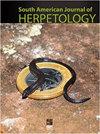帕尤尼Phymaturus payuniae分支的形态和遗传差异(鬣蜥:Liolaemidae)及两新种记述
IF 0.7
4区 生物学
Q4 ZOOLOGY
引用次数: 2
摘要
摘要payuniae Phymaturus分支是一种栖息在阿根廷中西部岩石露头的特有蜥蜴群。所有已知的物种都是在一个叫做“Payunia”的地方发现的。最近利用形态学数据和DNA标记的研究发现,payuniae分支至少包括10个终端分类群。在本研究中,我们重新审视了所有先前考虑的终端的形态,并分析了2005年和2016年在neuqusamin省发现的两个新种群。修订后的性状表使我们能够对几个在本研究之前形态未知的分类群的形态性状进行评分。在本研究中,我们对ND4的三个末端进行了测序(完成了这些分类群的其他序列),对Cytb、COI、12S和C-mos的一个末端进行了测序(未报道DNA数据)。然后,我们将这些序列添加到该属的现有DNA数据库中。我们估计了三个线粒体标记在所有分支成员之间的遗传距离,并计算了整个巴塔哥icus群体形态特征的进化稳定性。采用主成分分析法对payuniae分支所有成员及patagonicus和palluma类群其他分支的26个连续性状进行变异分析。此外,我们修改了所有成员的生殖器特征,并包括新分类群的半阴部形态的描述。考虑到种间形态特征的分布、遗传距离、不同的生殖形态以及推断出的系统发育结构,我们能够支持该类群所有种的分类地位,并增加2个新种的正式描述。本文章由计算机程序翻译,如有差异,请以英文原文为准。
Morphological and Genetic Divergence within the Phymaturus payuniae Clade (Iguania: Liolaemidae), with the Description of Two New Species
Abstract. The Phymaturus payuniae clade is an endemic group of lizards inhabiting rocky outcrops of central western Argentina. All recognized species are found in an area of endemism called “Payunia.” Recent studies using morphological data and DNA markers found that the payuniae clade comprises at least 10 terminal taxa. In the present study, we revisited the morphology of all previously considered terminals and analyzed two new populations discovered in Neuquén province in 2005 and 2016. The revised character list allowed us to score morphological characters for several taxa whose morphologies were unknown prior to this study. In the present study, we sequenced ND4 for three terminals (completing other sequences available for these taxa), and Cytb, COI, 12S, and C-mos for one terminal (for which no DNA data had been reported). We then added these sequences to the pre-existing DNA databases for the genus. We estimated genetic distances for three mitochondrial markers among all members of the clade and calculated the evolutionary lability of morphological characters for the whole patagonicus group. Variation of 26 continuous characters was analyzed with Principal Component Analysis for all members of the payuniae clade and species of other clades of the patagonicus and palluma group. Additionally, we revised genital characters for all members of the group and included a description of the new taxa's hemipenial morphology. Considering the distribution of morphological characters among species, their genetic distances, different genital morphology, and the phylogenetic structure inferred, we are able to support the taxonomic status of all species of the group and add the formal description of two new species.
求助全文
通过发布文献求助,成功后即可免费获取论文全文。
去求助
来源期刊
CiteScore
1.50
自引率
0.00%
发文量
10
期刊介绍:
The South American Journal of Herpetology (SAJH) is an international journal published by the Brazilian Society of Herpetology that aims to provide an effective medium of communication for the international herpetological community. SAJH publishes peer-reviewed original contributions on all subjects related to the biology of amphibians and reptiles, including descriptive, comparative, inferential, and experimental studies and taxa from anywhere in the world, as well as theoretical studies that explore principles and methods.

 求助内容:
求助内容: 应助结果提醒方式:
应助结果提醒方式:


